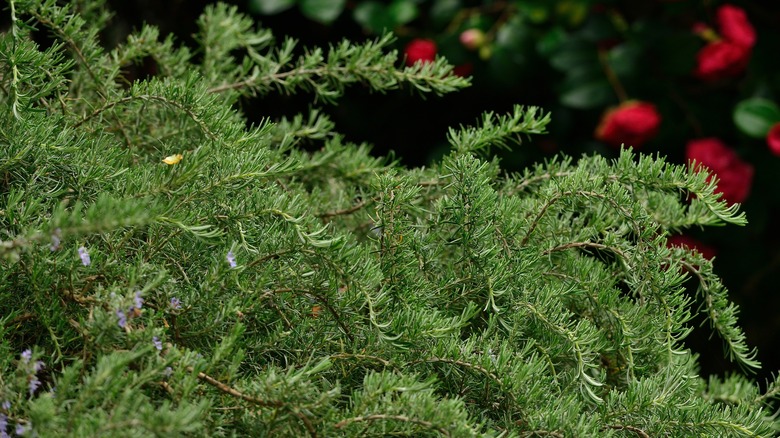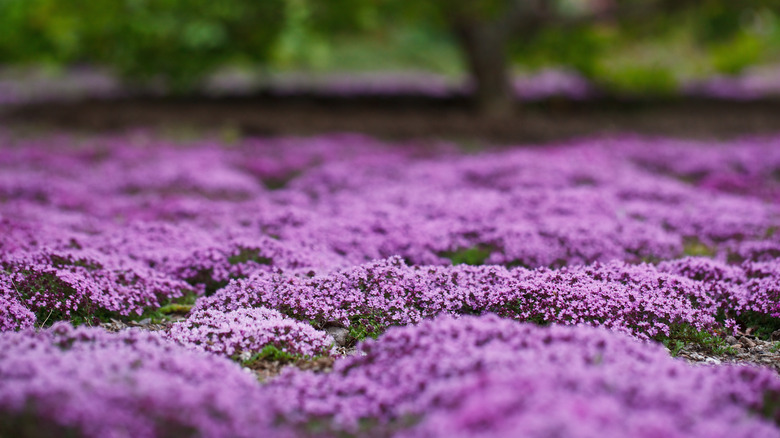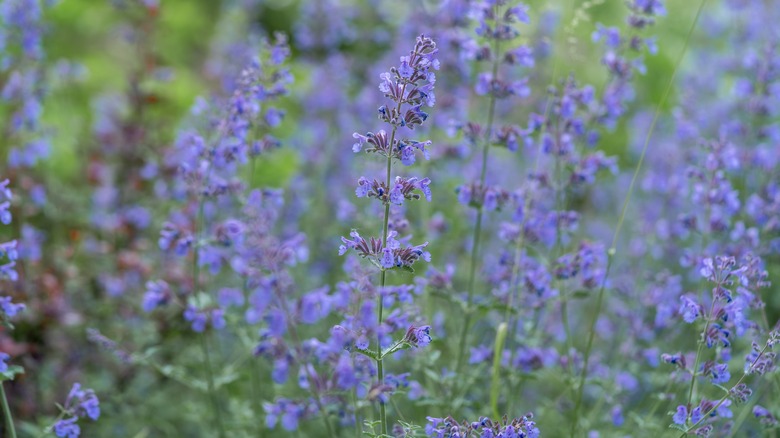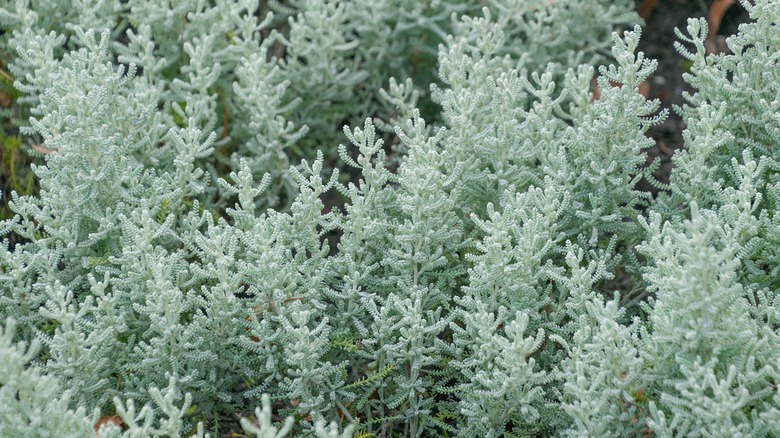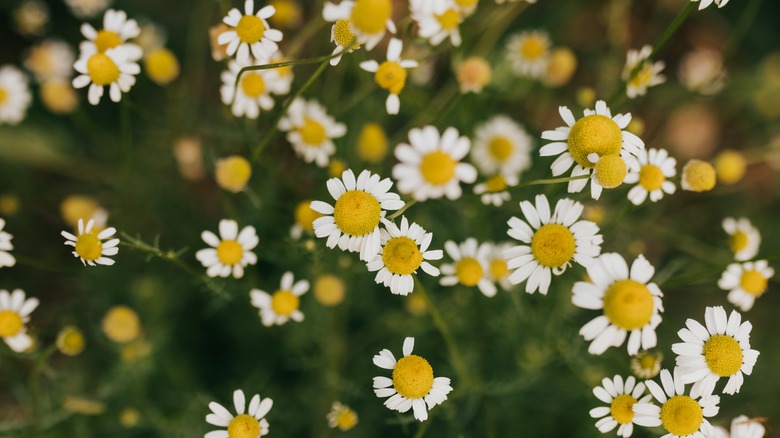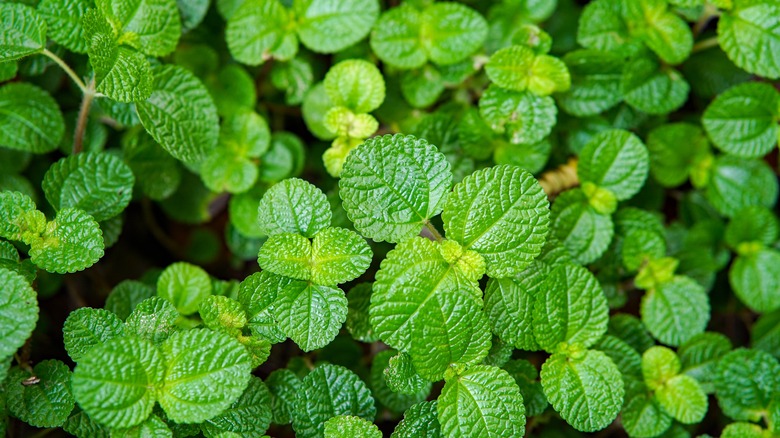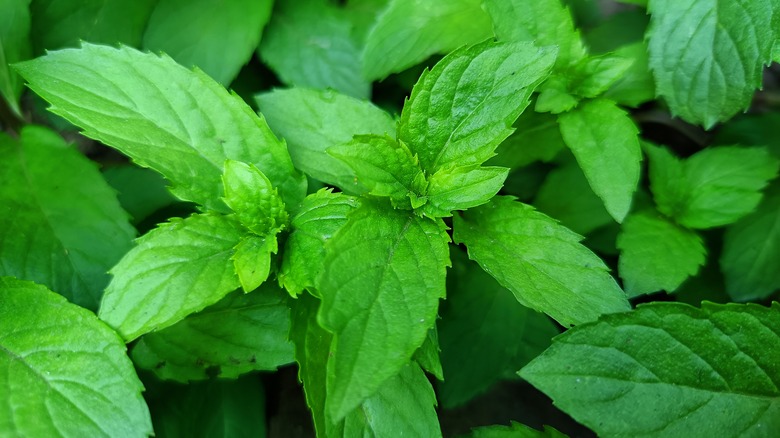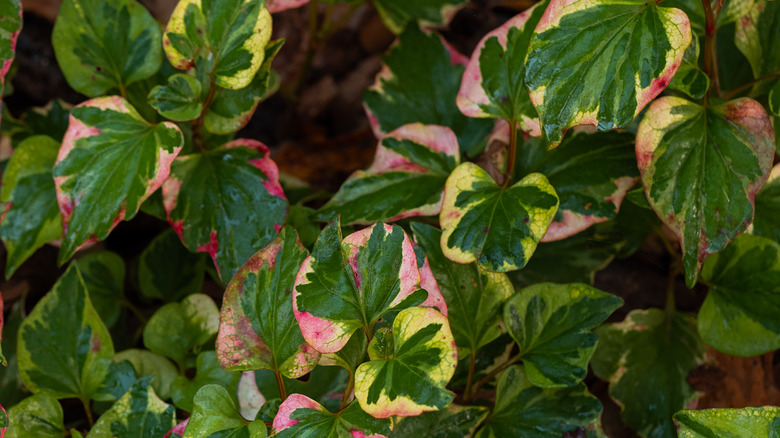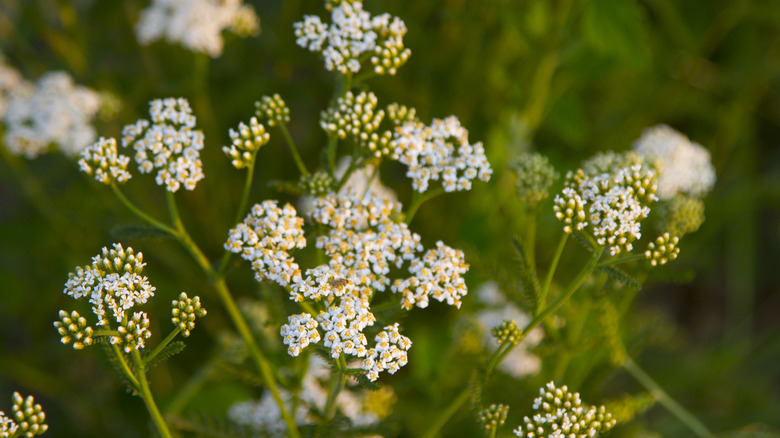5 Fragrant Ground Covers That Can Help Deter Pests (& 4 To Avoid)
One awesome reason for cultivating a garden is stepping into a sweet-smelling world that's all your own. And we emphasize all-your-own quite seriously because if there's one thing that needs to stay out of your garden, it's pests. Luckily, there are plants you can add to your outdoor space that will produce fragrant blooms you love but nuisance garden pests hate.
However, not all aromatic plants work out the way you hope, and may end up being more trouble than they're worth. That's why we're breaking down our top five favorite ground-covering plants that are not only full of fragrance, but will work like little garden bodyguards to deter pests — and the science behind how they do it. Plus, we'll cover another four potential candidates that seem like a good addition but are probably best left at the garden center. Here's a closer look.
Creeping rosemary has pesticidal properties
Creeping rosemary (Salvia rosmarinus var. 'Prostratus') is a type of rosemary that grows wide instead of tall, covering areas with its needle-like leaves and pretty blue flowers; it's like turning a traditional rosemary plant on its side. Since creeping rosemary is so close to its upright cousin, it carries a lot of its benefits, including its insecticidal properties. A 2020 study in "Molecules" looked at the compounds found in essential oils extracted from plants in the Lamiaceae family, which is commonly referred to as the mint family, but its umbrella covers way more than that: lavender, rosemary, thyme, etc. Researchers in the study found rosemary contained at least four compounds useful as pesticides: α-Pinene, which successfully repels some species of beetles; 1,8-cineole, which was toxic to mosquito larvae; limonene, which was toxic to weevil adults; and camphene, which was toxic to moth larvae.
That said, we feel we should mention that using essential oils differs from using a live plant. Essential oils are heavily concentrated and may contain compounds from dozens of the same plant species, whereas creeping rosemary would be one plant (or a few if you're planting multiple, but you get the point). However, just because essential oils are more concentrated doesn't necessarily mean they're better. Using the live plant gives you multiple benefits: ground-covering, aesthetic appeal, herbs for cooking, and potentially long-term pest control. Just know that the live plant might not give such instantaneous or foolproof results — but it's still worth giving it a shot.
Creeping rosemary does best in gardens with access to full sun conditions and well-draining soil. Since it's low to the ground, it doesn't do well in clay-heavy soil since it will retain too much moisture and leave it susceptible to stem rot. If your creeping rosemary starts to look a little leggy, prune it back; this will encourage it to get bushier. However, you might not want it to get too dense since rosemary is slightly susceptible to powdery mildew, and good air circulation will help prevent it from taking hold.
Several types of thyme work great for pest control
Thyme (Thymus spp.) is one of the prettiest herbs we've seen, but it's more than just a pretty face. In the aforementioned "Molecules" study, eight strains of thyme were found to contain seriously hardcore pesticidal compounds. Like rosemary, some strains contain camphene or α-Pinene, but they also found three more significant compounds (among others): Thymol, which is toxic to weevils; carvacrol, which is toxic to bed bugs; and ρ-cymene which was another compound toxic to mosquitoes. A 2017 study in "Scientific Reports" took this further, testing thymol and carvacrol extracted from common thyme (T. vulgaris) to see what they did against a newly discovered type of cicada. Putting it nicely, the compounds messed the cicadas up. Researchers also found that while they were super toxic for insects, they seemed to have relatively low toxicity levels for mammals, making them a potentially safe option for use as a pesticide where humans and pets live. Plus, there's strong evidence that thyme can keep ants from invading your garden, too. This stuff is magic.
One of the best reasons for choosing thyme as a groundcover is that you're not stuck with one kind; multiple varieties work well as pest-controlling groundcovers. Generally speaking, look for thymes in the Coccineus group since these are the creeping varieties. Creeping thyme (Thymus serpyllum), wooly thyme (Thymus pseudolanuginosus), caraway thyme (Thymus herba-barona), and any of the Thymus praecox cultivars would work great. Thyme needs full sun and well-draining soil. They're all somewhat drought-tolerant and hardy enough to be evergreen in places with mild winters.
Catmint might keep aphids and squash bugs away
Catmint (Nepeta), AKA Catnip, is also part of the mint family and has been studied for years as a potential host that's full of pesticide compounds. Both a 2018 and 2019 "Scientific Reports" study found it had some mosquito-repelling properties, while a 2019 study in "The Pan African Medical Journal" found its essential oil destroyed cell membranes of the fall armyworm, a pest that's particularly devastating to corn crops. There's also some evidence catnip's strong smell is repellent to aphids and squash bugs, making this a versatile plant that can keep some potential bad bugs out of your garden.
That said, know what you're getting into with planting catmint, because it's good at spreading. It's too good, really, because some parts of the U.S. consider it an invasive weed. The standard catmint variety, Nepeta cataria, isn't great as a groundcover since it likes to grow up instead of out, reaching up to three feet high. Instead, look for varieties built for staying low, like Nepeta racemosa, Nepeta 'Cat's Pajamas,' or Nepeta x faaseenii 'Kitten Around.' Most catmints need full sun, though 'Kitten Around' and racemosa can handle some shade. Racemosa and 'Cat's Pajamas' are drought tolerant and like well-draining soil, while 'Kitten Around' prefers soil that's consistently moist and won't tolerate drought. Both 'Cat's Pajamas' and 'Kitten Around' are sterile, meaning they won't self-seed, so if you're worried about taming your catmint, either of these strains is your best bet.
Lavender cotton can kill an aphid infestation
Lavender cotton (Santolina chamaecyparissus) is part of the Aster family, and its foliage looks a bit like little snow-capped trees. The leaves give off a smell some describe as musky or like a strong oregano. A 2021 study in "Insects" tested that pungent-smelling aromatic plant and found its essential oil created significant oxidative stress in two species of aphids. Basically, compounds in the essential oil create a reaction that messes with the aphid's mitochondria and damages its tissue to the point of no return. It's not a pretty sight, and a whiff of lavender cotton in your garden might be enough to send aphid scouts screaming.
Lavender cotton handles neglect like a champ once it settles in. It likes dry conditions and is drought-tolerant, preferring not to be bothered with lots of water or moisture. In fact, if you could put it in your worst, rockiest soil, that would be great because fertile soil with lots of organic material just makes it sad. Lavender cotton will prove its familial lineage by sometimes producing bright yellow flowers that look a little like dandelions or tansies.
Roman chamomile can help fight mosquitoes, aphids, and mites
Roman chamomile (Chamaemelum nobile/Anthemis nobilis) flowers have a calming fragrance that makes them perfect for sensory gardens or places where you just want a little peace. While you may love their smell, creepy garden pests are definitely not fans. A 2019 study in "Malaria Journal" found that a solution containing 20% Roman chamomile oil showed a 76.2% efficacy for repelling mosquitoes over eight hours. Scientists in another study isolated the compounds in Roman chamomile's essential oil and found it contained α-pinene, which we previously mentioned was beneficial for repelling mosquitoes. However, what's particularly interesting is that they found the α-pinene in Chamaemelum nobile was effective against a particular type of mosquito: Aedes aegypti, the mosquito most responsible for spreading the Dengue, Zika, and Yellow Fever viruses. If that's not enough to entice you, a 2004 study in "Veterinary Parasitology" found the essential oil was toxic to red mites, while a 2023 study in "Frontiers in Microbiology" noticed extracts from Roman chamomile to show promising results curbing aphid populations.
Roman chamomile likes full sun but can handle some shade. It spreads by creeping its roots to about a foot in diameter but will send its pretty, daisy-like flowers up to around six inches, which is why many gardening experts recommend planting it as a ground cover against a wall or fence. It's somewhat drought-tolerant but really does best in cooler climates or before the dog days of summer. Plant it in well-draining soil that's got a little bit of sand. Some gardeners like using it as a lawn replacement since it can handle mowing. However, only consider doing that if your lawn doesn't get a lot of attention, as Roman chamomile can't sustain being trampled over by heavy foot traffic. If your lawn's a little too popular, there are other ground cover plants you can grow instead of grass that can handle heavier foot traffic like a champ.
Creeping Charlie smells great but is too aggressive to control
Creeping Charlie (Glechoma hederacea), also known as ground ivy, is part of the mint family, so it's likely to help control common garden pests. When crushed, its leaves emit a minty smell that some people love, while others think is way too potent. It's originally from European and Asian continents but proudly calls itself an American, setting up shop and now growing wild in 46 of our 50 states.
Most nurseries will not carry it because of how invasive it is, though you might find it in the occasional hanging basket. But don't trust it, because creeping Charlie can root at every node, so it can escape from your hanging basket and crawl its long, trailing stems into somewhere you don't want it to live.
Mint has pesticidal properties, but you'll never be able to get rid of it
Mint is the key member of the Lamiaceae family and has lots of pest-repelling and killing properties. Different species have varying toxicity levels, but aphids, fruit flies, mosquitoes, and even deer sometimes can't handle the volatile organic compounds (VOCs) mints emit. Menthol and limonene are two particular VOCs that are potent and toxic to pests, so it's sad we have to put a mint on the bad side of this list.
But, mint is too good at its ground-covering job and becomes a prolific spreader, turning from ground-covering bud to weedy nemesis faster than you think. Its stems can root anywhere they make contact with the ground. Meanwhile, underground, the rhizomes spread undetected. It's really a perfect example of a hardy plant specimen that can outgrow and bully any plant, structure, or thing it comes in contact with.
Chameleon plants are pretty and fragrant, but not the right kind of fragrant
The Chameleon plant (Houttuynia cordata) is another plant to add to this ground-cover inventory's bad side, even though it has so many positive attributes. It's a very cool-looking plant with multi-colored leaves that has the potential to be a stunning lawn alternative in shady yards, and has been a staple of traditional Chinese medicine for years. It contains the compound 2-undecanone, which some researchers believe is comparable to DEET in terms of pesticidal capabilities. It also has loads of antifungal and antiviral bits in it, and was even considered a potential option for combating COVID.
However, two significant downsides make us recommend staying as far away from it as possible. First, it's nearly unstoppable once it's in the ground, and most garden experts recommend resorting to hardcore chemical herbicides, but even then, they make no promises or guarantees that you'll be able to kill it. Second, it stinks. It's undoubtedly fragrant, but not a fragrance you'd want to stop and smell, that's for sure. Some people characterize it as a foul fishy smell, which we'd assume is probably not the vibe you're shooting for in your happy garden place.
Yarrow has a wonderful spicy smell but is a super aggressive grower
Yarrow (Achillea millefolium) has a wonderfully spicy scent that makes it a unique candidate for a ground cover in your garden. There is some research showing it has potential as a pesticide, or at least a pest repellent, that deters sawflies and kills aphids, thanks to its chemical makeup. So why are we recommending you pick something else?
Because it's a super-aggressive grower, self-seeding like nobody's business while underground rhizomes work as a backup, ensuring this plant outpaces everything else in your garden. That said, some people have found a compromise with yarrow, opting to use it as a lawn replacement since it's so prolific, as long as it's not an area with too much foot traffic. As for gardens, it's better to stick to something that can be more easily controlled, like one of the options above.

